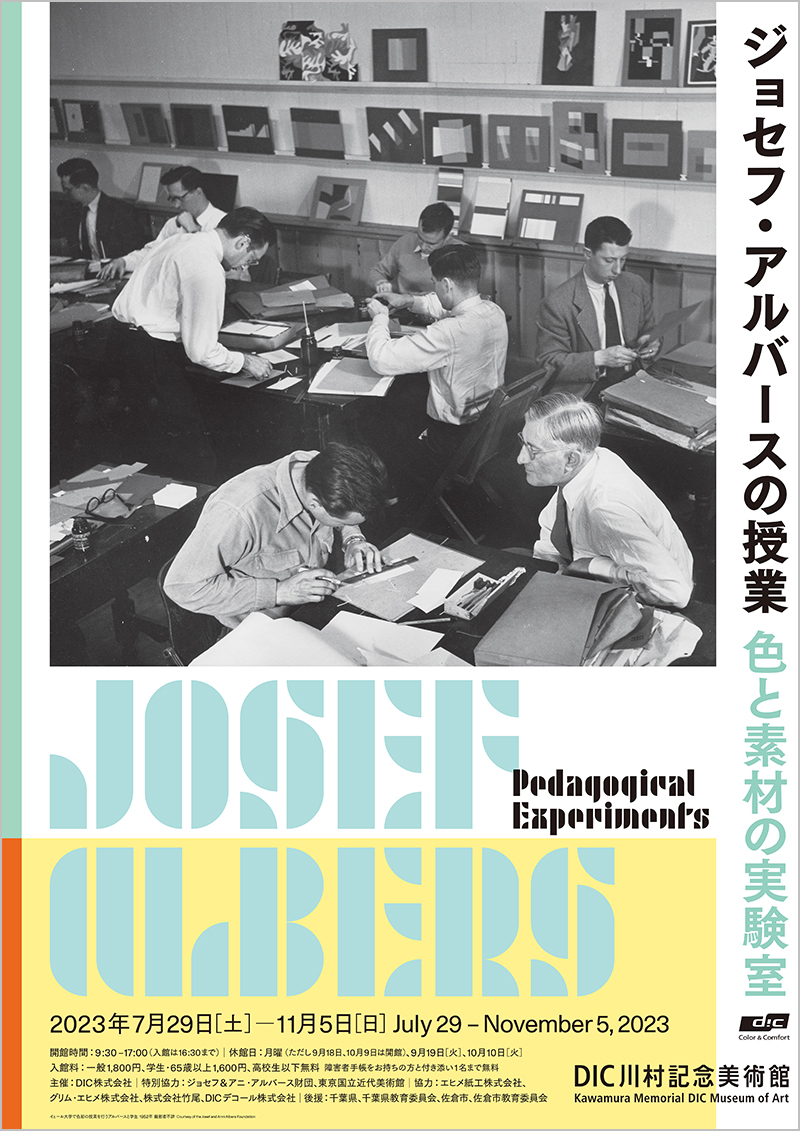Josef Albers
Pedagogical Experiments
July 29 - November 5, 2023
- Hours:
- 9:30-17:00 (last admission 16:30)
- Closed:
- Mondays (except Sep. 18, Oct. 9), Sep. 19, Oct. 10
- Organizer:
- DIC Corporation
- Special Cooperation:
- The Josef and Anni Albers Foundation, The National Museum of Modern Art, Tokyo
- Cooperation:
- EHIME SHIKO CO.,LTD., GRIMM・EHIME CO.,LTD., TAKEO Co., Ltd., DIC Decor, Inc.
- In Association with:
- Chiba Prefecture, The Board of Education of Chiba Prefecture, Sakura City, The Board of Education of Sakura City
Museum Admission
Adults ¥1,800
College / 65 and over ¥1,600
HS students and under Free
| Museum Admission | Adults | College 65 and over |
HS students and under |
|||
|---|---|---|---|---|---|---|
| ¥1,800 | ¥1,600 | Free |
*Free admission for disability pass holders and one care-giver for each
*College students includes vocational and preparatory school students
*High school students include technical/vocational upper secondary school students
*For Student discounts please show a student ID, for Senior discount please show proof of age
*The permanent collection exhibition can also be viewed with a special exhibition ticket
Outline
Josef Albers (1888–1976) was a painter, designer, and educator. Born in Germany, he studied at the Bauhaus, where he later became professor in charge of basic courses. After the school was shut down, he moved to the United States and taught at Black Mountain College as well as at Yale University, training important artists in postwar America.
Albers stated that the purpose of his classes was to “open eyes.” He did not simply teach knowledge; he assigned students exercises and encouraged them to think with their hands. He wanted them to discover the new possibilities of color and materials through such investigation. Albers himself continued to explore throughout his life. The result is an astonishingly diverse oeuvre, from the glass works of his Bauhaus period, to furniture and tableware designs, to the painting series “Homage to the Square.”
The first ever retrospective of Albers in Japan, this exhibition presents his work with photographs and films of his classes, as well as works by his students, examining his career both as an artist and an educator.
*The display will vary according to the periods (Period 1: July 29–September 18; Period 2: September 20–November 5)
Workshop: Experience Albers’s Teaching!
A workshop space will be set up for the exhibition’s entire duration where visitors can drop by to try their hands at Albers’s exercises. By actually using your hands, you will rediscover the wonder and fun of color. Videos are available to offer tips.
Exercise 1
The magic of color: One color appears to be two different ones
Exercise 2
Three color worlds: A single color can generate different
Exercise 3
Trick of transparency: The illusion of transparency when there is no transparency
Exercise 4
Lesson in folding: Ply and raise your supple sheet of paper up into a free-standing structure
*Albers and his students utilized everyday materials such as newspapers, magazines, and wrapping paper for their exercises. This workshop also addressed the upcycling of paper with the cooperation of four company, EHIME SHIKO CO.,LTD., GRIMM・EHIME CO.,LTD., TAKEO Co., Ltd., and DIC Decor, Inc.
Events
Lecture
Brenda Danilowitz (Chief curator of the Josef and Anni Albers Foundation)
"To See in a New Way: Josef Albers, Artist and Teacher"
Saturday, July 29, 13:30-15:30
- Prebooking required
Ryo Sawayama (Art critic)
"Josef Albers: the Association of Forms"
Saturday, September 23, 13:30-15:00
- Prebooking required
Gallery Talks by the Curator
Saturday, August 12
Sunday, September 17
Friday, October 20
Each start from 11:30
- Booking required on the day of your visit at the Museum’s reception desk.
Guided Tours
Daily, 14:00-15:00
- Booking required on the day of your visit at the Museum’s reception desk.
Special Workshop: Experience the Interaction of Color
Yasuhito Nagahara (Graphic designer, Supervisor of the Japanese edition of Josef Albers’s Interaction of Color)
Saturday, August 19, 13:30-15:30
Suitable for junior high school students and above
- Prebooking required
Workshop: Experience Albers’s Teaching!
Yūsuke Kameyama (Curator of the exhibition)
Thursday, August 10
Saturday, August 26
Saturday, September 9
Saturday, September 16
Friday, September 29
Monday, October 9
Saturday, October 21
Saturday, October 28
Each start from 11:30
*8 sessions. Each session takes up a different exercise.
Suitable for elementary school students and above
- Booking required on the day of your visit at the Museum’s reception desk.
Museum Concert: The Sound Museum of Theremin
The Puh=Machiko Machikado (Theremin), Machio Machikado (Guitar & Vocal)
Saturday, October 14, 18:00 Start
- Reservations required. See Japanese page for details.
